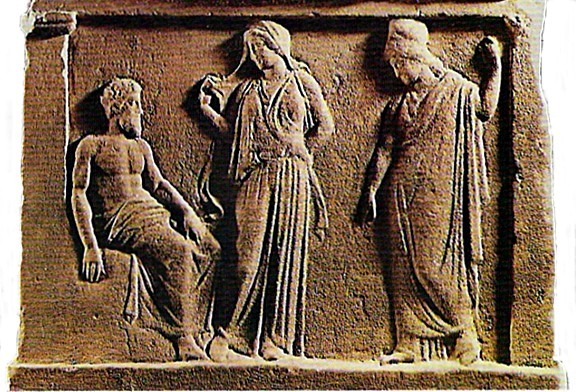Greek City-States
Sparta, located in central Greece on the banks of the Evrotas River, was ruled by Dorians who migrated to the region around 1100 BC. In the 6th century BC, Spartan society was totally focused on combat and the city was run like an army barracks. The Spartans were victorious against their neighbors, the Dorians of Messina and the Dorians of Argos, and defeated the Athenians in the Peloponnesian War. Spartans dominated the Mediterranean until 371 BC, when the Thebans pushed them back to their original territories. Under the Roman Empire the city became a Roman province until it was sacked by the Goths in 396 AD.
Corinth, founded by the Dorians circa 1000 BC, was one of the wealthiest and most powerful cities of Greece. Corinth joined Sparta against Athens in the Peloponnesian War, then sided with the Athenians against Sparta in the Corinthian War (395 BC - 387 BC.) A year later the city was occupied by the Macedonians and, in 146 BC, was destroyed by the Roman army. Rebuilt by Julius Cesar in 44 BC, Corinth became the capital of the Roman province of Achaea. Plundered by the Goths in 395, occupied by the Ottomans in 1458, defeated by the Venetians in 1687, reoccupied by the Ottomans in 1715, Corinth was recaptured by the Greeks in 1822 and destroyed by an earthquake thirty-six years later.
Thebes, located northwest of Athens, may have been founded by the Phoenicians circa 1000 BC. In Greek mythology the Phoenician king Cadmus slew a dragon and planted its teeth in the ground. From the teeth sprouted armed men who fought each other until only five were left. The five survivors founded Thebes. The city was later ruled by twin brothers, Amphion and Zethus, who allegedly built the city walls. Both Hercules and Oedipus were from Thebes. Oedipus’ sons would compete for the throne, resulting in the war of the Seven against Thebes.
In 479 BC the Thebans sided with the Persians when Persia planned an attack on Athens, and sided with Sparta in the Peloponnesian War. However, when they saw how powerful Sparta was becoming they allied with Athens and the Greek Confederation. Thebes had a short-lived control over the Mediterranean that lasted eleven years, until 362 BC.
Syracuse was founded on the island of Sicily in 734 BC by colonists from Corinth. The city grew rapidly and set up independent colonies. In 485 BC Syracuse’s democratic government was suppressed by the tyrant Gela, and his victory over Carthage five years later placed Syracuse as the most powerful city in Sicily. Gela was succeeded by his brother Heiro. A wise man and patron of the arts, he transformed Syracuse into one of the great Greek cultural centers. After Heiro’s death around 446 BC Syracuse became once again a democracy that lasted sixty years. In 414 BC the Syracusans defeated the Athenian army (led by the general Alcibiades) and were incremental in Sparta’s victory over Athens in the Peloponnesian War.
Between the 5th and 4th century BC Syracuse alternated between democracy and tyrant rule. The city continued to prosper until after the death of Heiro II, when Syracuse sided with Carthage against Rome in the 2nd Punic War. Syracuse succumbed to the Romans in 212 BC who, in reprisal, plundered the city.
Athens, named after the goddess Athena, was settled around 1400 BC by the Mycenaeans and was originally governed by kings.
Around 650 BC power went from the monarchy to the nobles. The city was burdened with economic problems and the citizens, unhappy with the way the Athens was managed, threatened to revolt.
To deal with the crisis the statesman Draco came up with a set of unpopular laws listed as the "Draconian Code".
In 594 BC the nobleman and statesman Solon was selected as chief magistrate in Athens to solve the economic depression, and his first step was to better the conditions of the farmers.
Farmers who could not pay their debts were customarily sold as slaves, which had aggravated the economic crisis. Solon canceled all debts and had farmers learn new professions, which helped business and trade. He made certain that each social level, from the wealthy aristocrats to the common people, shared the tax burden according to their means. He established a civil code and a public assembly where the people had a voice in the decision process. He also improved relations with foreign traders and beautified the city.
Though Solon pulled Athens from its depression he was ousted from office in 560 BC by the tyrant Pisistratos backed by the aristocrats. The term “tyrant” was used when someone took power by force - not all ruled oppressively. Pisistratos added more public buildings and turned the theatre into a major part of Athenian society. However, his sons did not enjoy the same popularity as their father. One was assassinated and the second, Hippias, moved to Persia after a democratic uprising organized by the statesman Cleisthenes in 509 BC.
Thirty years later the Persians sacked the Athens. With the help of other Greek states the Athenians recovered it a year later in the Persian War. Circa 450 BC Athens lived through its most prolific period, its Golden Age, under the statesman Pericles. Notwithsatnding, his arrogant foreign policy provoked a major conflict with Sparta, resulting in the Peloponnesian War (431-404 BC) that ended in a crushing defeat for the Athenians. With its military resources drained the city was vulnerable to outside attacks. Athens was occupied by the Macedonians in 338 BC, by the Romans in 197 BC, and by the Ottoman Turks in the 18th century.
